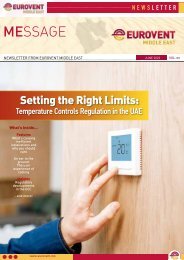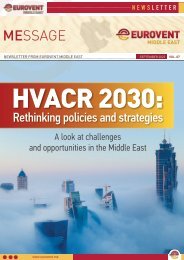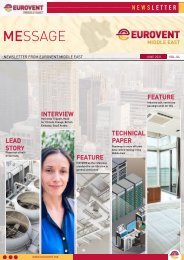EME Newsletter MEssage #1/2022
HVACR Industry news from Eurovent Middle East
HVACR Industry news from Eurovent Middle East
Create successful ePaper yourself
Turn your PDF publications into a flip-book with our unique Google optimized e-Paper software.
NEWSLETTER<br />
TECHNICAL PAPER<br />
International regulations and<br />
standards for testing IAC’s<br />
The test procedures for Air<br />
Conditioners are slightly different<br />
between each governing body.<br />
With different climates and<br />
equipment markets in each<br />
country, the high and low<br />
temperature test conditions<br />
each test procedure are slightly<br />
different. This section discusses<br />
the scope of each test procedure<br />
and reviews their similarities<br />
when testing the IAC’s[8].<br />
• ISO<br />
The ISO standard 5151, which is<br />
incorporated either by reference<br />
or in full by many countries,<br />
applies to non-ducted air-cooled<br />
ACs and air-to-air heat pumps,<br />
and small ducted ACs and heat<br />
pumps. The scope of the standard<br />
covers both packaged and split<br />
systems but limits the split<br />
systems to multi-split systems<br />
controlled by a single thermostat.<br />
The standard specifies that single<br />
capacity, variable capacity, and<br />
multiple capacity units are also<br />
covered.’<br />
• Australia<br />
The Australian standard, AU/<br />
NZ 3823.4.1, covers air-cooled<br />
ACs and air-to-air heat pumps.<br />
This test method is the ISO 16358<br />
standard, which incorporates<br />
the entire scope of ISO 5151, ISO<br />
13253, and ISO 15042. ISO 13253<br />
covers ducted air-cooled air<br />
conditioners and ducted air-to-air<br />
heat pumps. ISO 15042 is the test<br />
procedure that covers multi-split<br />
and multi-circuit non-ducted<br />
systems. Both single and variable<br />
capacity systems are covered.<br />
• China<br />
The Chinese standard GB/T 7725-<br />
2004 test procedure applies to<br />
non-ducted units with a cooling<br />
capacity below 14 kW. The units<br />
can be either water-cooled or aircooled.<br />
• European Union<br />
The EU test procedure covers<br />
both packaged and split system<br />
ACs and heat pumps. These<br />
products can be variable<br />
capacity by any means, ducted<br />
or non-ducted, single-split<br />
or multi-split systems. The<br />
definition for multi-split<br />
from the EU aligns with the<br />
US definition (below). As for<br />
IAC’s the EN 14511 clearly<br />
states that the setting of the<br />
frequency shall be done for<br />
each rating condition. The<br />
manufacturer shall provide in<br />
the documentation information<br />
about how to obtain the<br />
necessary data to set the<br />
required frequencies and/or<br />
the fan when different from<br />
the maximum one to set on the<br />
control device for a given rating<br />
condition.<br />
It even allows when skilled<br />
personnel with knowledge of<br />
control software is required<br />
for the start of the system, the<br />
manufacturer or the nominated<br />
agent should be in attendance<br />
when the system is being<br />
installed and prepared for tests.<br />
- Japan<br />
The Japanese standard JIS<br />
B 8615-1:2013 and JIS B<br />
9612:2013 applies to packaged<br />
and split system ACs with a<br />
rated cooling capacity of 10<br />
kW or less. Japan references<br />
ISO 5151 for its standard, with<br />
country specific adjustments to<br />
the testing conditions.<br />
• Korea<br />
Korea’s standard KS C 9306<br />
2017 test procedure is limited<br />
to packaged and split systems<br />
with a rated cooling capacity<br />
of 35 kW or less. The main<br />
deviation in scope from the<br />
other countries is the exclusion<br />
of split systems with multiple<br />
indoor units.<br />
• United States<br />
The test procedure established by<br />
the United States was updated in<br />
2017, and a new test procedure<br />
will go into effect in 2023. The<br />
current test procedure covers<br />
both heat pumps and ACs<br />
configured as single package<br />
units and split system units. The<br />
standard specifies that the split<br />
system units can be designed as<br />
multi-head mini split, multi-split,<br />
and multi-circuit systems.<br />
As a US certification body,<br />
the AHRI standard 1230-2010<br />
allows skilled personnel from<br />
the manufacturer to intervene<br />
to set the control software for<br />
an IAC. In addition to setting the<br />
compressor frequency needed<br />
to operate at targeted nominal<br />
capacity.<br />
- Canada<br />
The Canadian testing procedure<br />
are presented in the CSA EXP07<br />
SCOP, ICOP. It allows using both<br />
air enthalpy and calorimeter room<br />
methods depending on the type of<br />
the unit. It covers both fixed and<br />
variable speed compressor types.<br />
In all the presented standards,<br />
variable capacity units are<br />
currently tested at fixed<br />
compressor speeds. When<br />
installed, the speed of the<br />
compressor increases/decreases<br />
dynamically to condition the<br />
space. To test these units in<br />
a fixed-speed mode, a lab/<br />
testing body must contact the<br />
manufacturer to upload specific<br />
software or connect specific<br />
equipment to force the unit into<br />
a testing mode. The necessity of<br />
manufacturer intervention when<br />
testing these units opens up the<br />
procedure to interference by<br />
allowing changes to be made to<br />
the unit that are not present when<br />
operating in the field.<br />
While there is no other available<br />
solution in the present, both<br />
Canada and the EU are working<br />
to establish dynamic load-<br />
based test procedures for<br />
room air conditioners and heat<br />
pumps. These proposed test<br />
methods (CSA EXP07 and EN<br />
14825) use an adaptation of<br />
the psychrometric approach<br />
to introduce sensible and<br />
latent heat loads to the indoor<br />
room and test the unit’s<br />
control scheme for managing<br />
space temperature. The<br />
goal of developing these test<br />
procedures is to reflect the<br />
operation of a unit more closely<br />
in the field, which would better<br />
characterize unit operation at<br />
lower temperatures, better<br />
represent the efficiency gains<br />
associated with variable speed<br />
equipment and eliminate the<br />
ability to override controls.<br />
There are other initiatives such<br />
as keeping the same test method<br />
but introducing verification after<br />
or before the test to check that<br />
the inverter unit run at the same<br />
parameters in real life conditions<br />
than those used for the test.<br />
These test procedures are in the<br />
process of being developed, and<br />
some have raised concerns that<br />
the inherently dynamic nature of<br />
such test approaches may make<br />
them difficult to reproduce. Until<br />
one of these methods is valid<br />
enough, referring to a third-party<br />
certification body that controls<br />
the communication between the<br />
laboratory and the manufacturer<br />
could be the best available solution<br />
for testing an IAC by allowing<br />
Figure 5: Certified Air Conditioner by ECC following 2021 campaign<br />
Figure 6: test results for the 2020 qualification campaign<br />
the manufacturer to provide<br />
the required parameters for<br />
testing while ensuring no further<br />
modifications or intervention on<br />
the unit.<br />
Eurovent Certita Certification<br />
(ECC) feedback and experience<br />
Established in 1993, Eurovent<br />
Certita Certification is recognized<br />
as a world leader in third-party<br />
product performance certification<br />
in the Heating, Ventilation, Air<br />
Conditioning, and Refrigeration<br />
fields. In the Technical<br />
Certification Rules document<br />
(TCR)[9] for the Air-conditioners,<br />
it covers in its scope Comfort<br />
air cooled air conditioners and<br />
air/air heat pumps rated up to<br />
100 kW cooling capacity. The<br />
program follows the standards<br />
EN 14511 and EN 14825 for the<br />
testing methods and procedures.<br />
All the certified products and<br />
performances are available the<br />
ECC website [10].<br />
In application of the Certification<br />
Manual (CM) and the TCR of<br />
the program, ECC forbid any<br />
direct communication between<br />
the manufacturer and the<br />
laboratory. The communications<br />
should be restricted with those<br />
allowed by the standards such as<br />
installation/ start up procedure<br />
and information about the<br />
compressor frequency and fan<br />
speed for the case of inverter.<br />
This information is collected using<br />
a locked document provided to<br />
the manufacturer by ECC and the<br />
necessary information are then<br />
transferred to the laboratory. Any<br />
further required information by<br />
the laboratory should be acquired<br />
by the intermediate of the<br />
certification team.<br />
Currently ECC have 6217<br />
certified Air-Conditioner on its<br />
website. The IAC’s represent the<br />
larger part of these products<br />
(Figure 5). The control of all<br />
communication between the<br />
laboratory and the manufacturer<br />
guarantees the testing body<br />
should have all the required<br />
www.eurovent.me MAY <strong>2022</strong> VOL. 01











